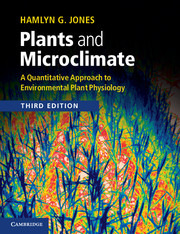Book contents
- Frontmatter
- Contents
- Preface
- Acknowledgements
- Symbols
- Main abbreviations and acronyms
- 1 A quantitative approach to plant–environment interactions
- 2 Radiation
- 3 Heat, mass and momentum transfer
- 4 Plant water relations
- 5 Energy balance and evaporation
- 6 Stomata
- 7 Photosynthesis and respiration
- 8 Light and plant development
- 9 Temperature
- 10 Drought and other abiotic stresses
- 11 Other environmental factors: wind, altitude, climate change and atmospheric pollutants
- 12 Physiology and crop yield improvement
- Appendices
- References
- Index
3 - Heat, mass and momentum transfer
Published online by Cambridge University Press: 05 June 2014
- Frontmatter
- Contents
- Preface
- Acknowledgements
- Symbols
- Main abbreviations and acronyms
- 1 A quantitative approach to plant–environment interactions
- 2 Radiation
- 3 Heat, mass and momentum transfer
- 4 Plant water relations
- 5 Energy balance and evaporation
- 6 Stomata
- 7 Photosynthesis and respiration
- 8 Light and plant development
- 9 Temperature
- 10 Drought and other abiotic stresses
- 11 Other environmental factors: wind, altitude, climate change and atmospheric pollutants
- 12 Physiology and crop yield improvement
- Appendices
- References
- Index
Summary
Chapter 2 considered radiative energy exchange between plants and their environment. Other ways in which plants interact with their aerial environment include the transfer of matter, heat and momentum. The mechanisms involved in mass transfer processes, such as the exchanges of CO2 and water vapour between plant leaves and the atmosphere, and in heat transfer, are very closely related so will be treated together. These can be broadly divided into those operating at a molecular level that do not involve mass movement of the medium (i.e. diffusion of matter and conduction of heat) and those processes, generally termed convection, where the entity is transported by mass movement of the fluid. The forces exerted on plants by the wind are a manifestation of momentum transfer.
Clear discussion of heat and mass transfer processes may be found in Campbell (1998) and in Monteith and Unsworth (2008) and a number of more advanced treatments (Cussler, 2007; Garratt, 1992; Kaimal & Finnigan, 1994; Monteith, 1975, 1976). The physical principles underlying these transfer processes and the analogies between them are outlined in this chapter, and this information is used to analyse transfer between the atmosphere and both single leaves and whole canopies. Although the principles described are applicable to transfer in any fluid, the examples in this chapter will be confined to transfer in air.
Measures of concentration
Before going into details of the different mechanisms of heat and mass transfer it is necessary to define what is meant by concentration.
- Type
- Chapter
- Information
- Plants and MicroclimateA Quantitative Approach to Environmental Plant Physiology, pp. 47 - 67Publisher: Cambridge University PressPrint publication year: 2013
- 1
- Cited by



